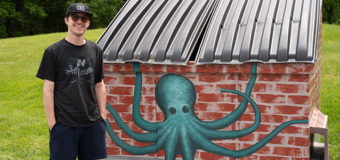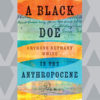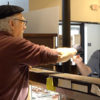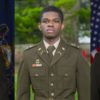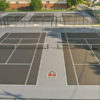Students Spend Their “Alternative Breaks” in Service and Learning
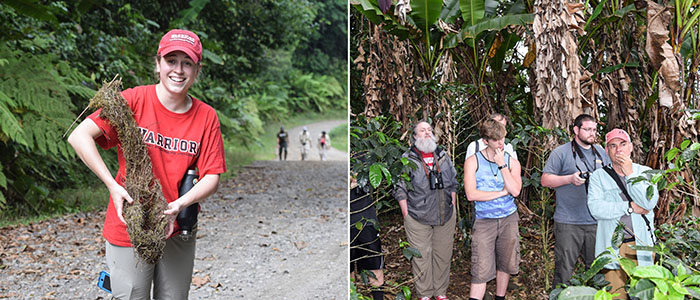
Posted by: Elizabeth Richardson on April 17, 2018, No Comments
“I’m not very handy, but I don’t mind getting dirty.”
Nick Vloyanetes ’18 was lying under a double wide wrecked by Hurricane Matthew in 2016. Stripped down to its struts, the home was getting new insulation, siding, roof, flooring and walls.
Is this any way to spend your spring or winter break? You bet it is.
The words “spring break” conjure up images of students kicking back on sunny beaches and partying. But many ESU students and faculty had better ideas for an “alternative” break. Like helping after disaster or traveling abroad to learn about transatlantic relations and ecological tourism.
Vloyanetes was one of the ESU students who went to North Carolina during winter break with Professor Gene White, Ph.D., and students from several other universities. Getting dirty is a big part of the job. White says this year, in a single eight-hour day, the students removed and replaced the roof of a home, built steps to the front porch, and painted the entire house.
This was the 12th disaster relief trip for White and his students, and the second for Vloyanetes, whose own home was devastated by Hurricane Sandy and refurbished by “many friends and strangers. So this is my way to give back and help out.”
In March, ESU students did more dirty work – 312 service hours, from sunrise to sunset – at Virginia State Park in Cumberland, Va. They cleared hiking trails and campgrounds and rerouted hiking trails to redirect water and reduce erosion. The trip was a broad learning experience, with presentations by rangers on park management, environmental science, reducing carbon footprints and more. The project, organized by the Student Activity Association (SAA), was led by director of student engagement Fernando Alcantar and grad student Alvin (Wenxiao) Shang.
John Longnecker ’20, an environmental science major, says his work included running wheelbarrows filled with stone up steep hillsides, and using heavy tools to reroute trails, with a healthy crop of blisters to show for it. But the effects of the experience were far more than physical, says Alcantar. “I could see the changes in the group, and the conversations on the way home were thick with meaning.”
Other alternative breaks were equally stimulating, although a lot less physical, in Costa Rica, Belgium and Germany learning about international business and tourism, transatlantic relations, the biology of tropical ecosystems and the European Union.
Professor Terry Master, Ph.D., Associate Professor Thomas LaDuke, Ph.D., and Professor Howard Whidden, Ph.D., explored the biology of tropical ecosystems in Costa Rica. Students worked in two different ecosystems — the hot humid lowlands (with a marathon 14-K hike) and at elevations up to 10,000 feet – observing and identifying rain forest mammals, birds, plants and amphibians.
Master notes that “It is important for students to gain a global perspective on biodiversity and environmental issues in this age of extinction and environmental problems that affect the entire earth. Costa Rica, one of the most environmentally friendly nations on earth, is the perfect place to begin.”
Other students tackled Costa Rica’s global business, tourism and environmental sustainability, exploring totally green hotels in the cloud forest, meeting CEOs and senior management of businesses like Boston Scientific Costa Rica, which manufactures cardiology, urology and endoscopy products, and Café Britt, a producer of organic free trade coffee. They also had time for a little snorkeling and sightseeing. Steve Ives, director of international programs, led the trip with Associate Professor Li-Ming (Stanley) Chiang, Ph.D.
Emily Lind ’19, a recreation services management major aiming for a career with the National Park Service, was impressed with the country’s emphasis on sustainability. “It was good to talk about the difficulties of the import/export industry, and how important the preservation of the land and natural resources is, even designing a hotel so it doesn’t disrupt migration patterns.”
“It was unnerving,” Devin Heffernan ’19, says of his visit to the Verdun battlefield and destroyed village. “Seeing the war memorials and the different sites gave me a lot to think about.”
Heffernan and fellow students spent spring break in Germany as part of ESU’s Seminar on Transatlantic Relations with Associate Professor of History Christopher Brooks, Dr. Phil., coinciding with the 100th anniversary of the end of World War I. In addition to touring major historic sites, students spent seven days in seminars with key policy makers at The European Academy of Otzenhausen, Germany, a program designed to give deep insight into European integration, history and economic implications.
During winter break, students also attended the International European Union Simulation (Eurosim) in Brussels, Belgium, in a course led by L. Johan Eliasson, Ph.D., professor of political science.
The rigorous, four-day exercise gives students from European and American colleges and universities hands-on experience with the challenges of the European Union, the world’s largest single market and largest economy, as well as international law, negotiating strategy and diplomatic protocol using real life legal and policy problems. Eliasson wants his students to learn from exposure to different cultures, norms, policies and laws. “The hands-on experience they receive from Eurosim is unlike any other. It’s not just academic. The students are able to connect and network with so many people from around the world.”
Provost and Vice President for Academic Affairs Joanne Bruno, J.D., agrees. “I strongly encourage and support faculty/student projects and trips during semester and spring breaks that provide students with real life experiences with different cultures and service projects. Such experiences only enhance and bring meaning to their college education.”
ESU not only actively supports these alternative break projects, the University also helps make them accessible by subsidizing students’ expenses through the Office of the Provost and SAA.
For students, alternative break projects have several benefits. For many, it was their first travel abroad — for some their first time on a plane. They also see the value to their futures, in the tourism industry, in environmental science, in business, government or public service.
Bruno says, “The whole point to education today is making it relevant, and these ‘applied’ opportunities for students with their faculty truly engage students and enhance learning.”
Mason Henning ’18 sums it up. “At our farewell from the European Academy of Otzenhausen, the president explained why they host students from all over the world. Because youth are the future. He said we would make connections with other people, and in return make the world that much of a smaller and more peaceful place.”
